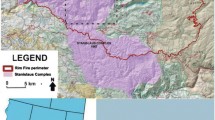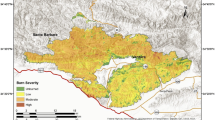Abstract
As populations continue to move into more mountainous terrain, a greater understanding of the processes controlling debris flows has become important for the protection of human life and property. The potential volume of an expected debris flow must be known to effectively mitigate any hazard it may pose, yet an accurate estimate of this parameter has to this point been difficult to model. To this end, a probabilistic method for the prediction of debris flow volumes using a database of 1351 yield rate measurements from 33 post-wildfire, runoff-generated debris flows in the Western USA is presented herein. A number of geomorphological, climatic, and geotechnical basin characteristics were considered for inclusion in the model, and correlation analysis was conducted to identify those with the greatest influence on debris flow yield rates. Groupings within the database were then clustered based on their similarity levels; a total of six clusters were identified with similar slope angle and burn intensity characteristics. For each of these six clusters, a probability density function detailing the distribution of yield rates within the cluster was developed. The model uses a Monte Carlo simulation to combine each of these distributions into a single probabilistic model for any basin in which a debris flow is expected to occur. This approach was validated by applying the model to ten basins that experienced debris flows of known volumes throughout the Western USA. The model predicted nine of the ten debris flow volumes to within the 95% confidence interval of the final distribution; a regression analysis for the ten volumes resulted in an R 2 of 0.816. These results compared favorably with those generated by an existing volume model. This approach provides accurate results based on easily obtainable data, encouraging widespread use in land planning and development.













Similar content being viewed by others
References
Bovis MJ, Jakob M (1999) The role of debris flow supply conditions in predicting debris flow activity. Earth Surf Process Landf 24:1039–1054
Calvo B, Savi F (2009) A real-world application of Monte Carlo procedure for debris flow risk assessment. Comput Geosci 35(5):967–977
Cannon SH, Powers PS, Savage WZ (1998) Fire-related hyperconcentrated and debris flows on Storm King Mountain, Glenwood Springs, Colorado, USA. Environ Geol 35(2–3):210–218
Cannon SH, Gartner JE (2005) Wildfire-related debris flow from a hazards perspective: in Debris Flow Hazards and Related Phenomena, Springer Praxis Books, pp.445–487
Cannon SH, Gartner JE, Rupert MG, Michael JA, Rea AH, Parrett C (2010) Predicting the probability and volume of postwildfire debris flows in the intermountain western United States. Geol Soc Am Bull 122(1/2):127–144
Cao, F., Delon, J., Desolneux, A., Muse, P., Sur, F., 2004, An a contrario approach to hierarchical clustering validity assessment: Institut National de Recherche en Informatique et en Automatique Research Report 5318.
Cruden DM, Varnes DJ (1996) Landslide types and processes: in landslides. investigation and mitigation 247:36–75
Doehring DO (1968) The effect of fire on geomorphic processes in the San Gabriel Mountains, California: in R.B. Parker (ed.), Contributions to Geology 7, pp. 43–65
Gartner JE (2005) Relations between wildfire related debris-flow volumes and basin morphology, burn severity, material properties and triggering storm rainfall: University of Colorado, M.A. Thesis
Gartner JE, Cannon SH, Santi PM, Dewolfe VG (2008) Empirical models to predict the volumes of debris flows generated by recently burned basins in the western U.S. Geomorphology 96:339–354
Gatwood E, Pederson J, Casey K (2000) Los Angeles district method for prediction of debris yields: U.S. Army Corps of Engineers, Los Angeles District, 145 pp
Giraud RE, McDonald GN (2007) The 2000–2004 fire-related debris flows in Northern Utah: in Schaefer, V.R., Schuster, R.L., Turner, A.K. (eds.), Conference Presentations, 1st North American Landslide Conference, Vail, CO. AEG Special Publication 23, pp. 1522–1531
Halkidi M, Batistakis Y, Vazirgiannis M (2001) On clustering validation techniques. J Intell Inf Syst 17(2/3):107–145
Hammond CJ, Prellwitz RW, Miller SM (1991) Landslide hazard assessment using Monte Carlo simulation: in Bell, D.H. (ed.), Landslides/Glissements de terrain: Proceedings of the Sixth International Symposium, Christchurch, New Zealand, Vol. 2, pp. 959–964
Huebl J, Fiebiger G (2005) Debris-flow mitigation measures: in Debris Flow Hazards and Related Phenomena, Springer Praxis Books, pp. 445–487.
Hungr O, Morgan GC, Kellerhals R (1984) Quantitative analysis of debris torrent hazards for design of remedial measures. Can Geotech J 21:663–677
Iverson RM (1997) The physics of debris flows: review of. Geophysics 35(3):245–296
Johnson PA, McCuen RH, Hromadka TV (1991) Magnitude and frequency of debris flows. J Hydrol 123:69–82
Major JJ, Iverson RM, McTigue DF, Macias S, Fiedorowicz BK (1997) Geotechnical properties of debris-flow sediments and slurries: in Debris-Flow Hazards Mitigation: Mechanics, Prediction and Assessment, Proceedings of First International Conference, pp. 249–259
Marchi L, D’Agostino V (2004) Estimation of debris-flow magnitude in the eastern Italian Alps. Earth Surf Process Landf 29:207–220
Meyer GA, Pierce JL, Wood SH, Jull AJT (2001) Fire, storms, and erosional events in the Idaho Batholith. Hydrol Process 15:3025–3038
Prochaska AB, Santi PM, Higgins JD (2008) Debris basin and deflection berm design for fire-related debris flow mitigation. Environmental &Engineering Geoscience XIV(4):297–313
Santi PM, deWolfe VG, Higgins JD, Cannon SH, Gartner JE (2008) Sources of debris flow material in burned areas. Geomorphology 96:310–321
Santi PM, Hewitt K, VanDine DF, Barillas Cruz E (2011) Debris flow impact, vulnerability, and response. Nat Hazards 56:371–402
Schimming DC (2012) Yield rates for debris flows in burned areas in the western United States: Colorado School of Mines, M.S. Thesis
Shonkwiler, R.W., Mendivil, F., 2009, Explorations in Monte Carlo Methods, Springer New York.
U.S. Geological Survey, U.S. Forest Service (2013) Monitoring trends in burn severity assessment of Fire Information: USGS and USFS, http://edc.usgs.gov
U.S. Geological Survey (2013) National elevation dataset: USGS, Sioux Falls, SD
Wang H, Wang G, Wang F, Sassa K, Chen Y (2008) Probabilistic modeling of seismically triggered landslides using Monte Carlo simulations. Landslides 5:387–395
Wohl EE, Pearthree PP (1991) Debris flows as geomorphic agents in the Huachuca Mountains of southeastern Arizona. Geomorphology 4:273–292
Yu B, Li L, Wu Y, Chu S (2013) A formation model for debris flows in the Chenyulan River watershed, Taiwan. Nat Hazards 68(2):745–762
Acknowledgements
Funding for this research was provided by the National Interagency Fire Center, Joint Fire Science Program, Grant No. 12-2-01-35.
Author information
Authors and Affiliations
Corresponding author
Rights and permissions
About this article
Cite this article
Donovan, I.P., Santi, P.M. A probabilistic approach to post-wildfire debris-flow volume modeling. Landslides 14, 1345–1360 (2017). https://doi.org/10.1007/s10346-016-0786-3
Received:
Accepted:
Published:
Issue Date:
DOI: https://doi.org/10.1007/s10346-016-0786-3




